 USA (1887-90): Protected Cruiser C-4 1890-1926
USA (1887-90): Protected Cruiser C-4 1890-1926WW1 and prewar USN Cruisers
Atlanta class | USS Chicago | USS Newark | USS Charleston | USS Baltimore | USS Olympia | USS Philadelphia | USS San Francisco | Cincinatti class | Montgomery class | Columbia class | New Orleans class | Denver class | Chester class | Omaha classUSS New York | USS Brooklyn | Pennsylvania class | Saint Louis class | Tennessee class
Authorized in 1887, USS Philadelphia was rigged as three-mast schooner, without head gear and generally similar to the USS Baltimore in protection notably. The armament and armour scheme as also remarkably similar so the two ships are even often classed as sister-ships by some authors. Philadeplhia was built at Cramp in 1888-89, completed in July 1890. She was sent to Puget sound in 1902 for and extensive overhaul. but in 1904 she was decommissioned as cruiser and became a receiving ship at puget sound, with a small period as prison ship until 1926.
The fourth USS Philadelphia (C-4) (later IX-24) was the alo the 6th protected cruiser of the United States Navy, designed by the Navy Department with a hull ibspired by the British-designed Baltimore, but with a uniform main armament of twelve 6-inch guns. Laid down 22 March 1888 at William Cramp & Sons in her namesake city, she was launched 7 September 1889 and commissioned 28 July 1890 under Capt. Albert S. Barker as first captain.
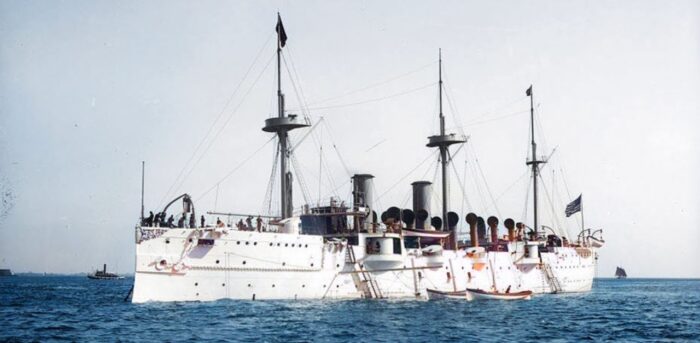
Development
After the ABCD cruisers which caracterized the new choices made by the USN in 1885 (The “New Navy”) alongside the first capital ships that were USS Texas and USS Maine, a new generation of crisers was defined in 1887. ABCD comprised for memory Atlanta, Boston (same class), Chicago (1885), and the dispatch vessel Dolphin. These were succeeded by a serie of protected cruisers which were given a pennant (C). The first was USS the masted cruiser USS Newark (C-1), USS Charleston (C-2) and USS Baltimore (C-3). On the latter we treated Philadelphia as a sister ship, but here is a dedicated post to see her more in detail. It is important to notice that both Charleston and Baltimore were designed in Britain, in order for the US to keep track of the best shipbuilding practices back in Europe.
Charleston was designed by Armstrong, and similar to the Naniwa launched in 1885. Baltimore had plans prepared for the same company but very different. The purchase of these plans was a bargain actually: They were similar to an unsuccessful Armstrong bid for the Spanish cruiser Reina Regente. Most of the work was already done. Unlike Charleston, these plans included a modern triple expansion engine designed by Humphrys, Tennant & Co. USS Philadelphia just capitalized on the design, with differences and improvements.
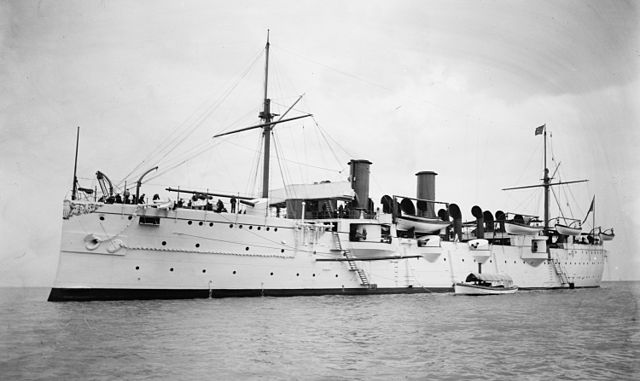
USS Philadelphia’s Design
Hull and general design
USS philadelphia was as large as baltimore and shared the same hull design overall, tall, with a forecastle and poop, and a battery deck amidships. she measued 335 ft (102 m) overall for 327 ft 6 in (99.82 m) between perpendiculars, for a beam of 48 ft 6 in (14.78 m) and a forward mean draught of 19 ft 6 in (5.94 m) and aft max draft of 23 ft 6 in (7.16 m). Her hull had the same trademarks as Baltimore, with a pointy arched poop, ram bow, and tall freeboard with three portholes stages. Two funnels, two short masts fore and aft. Albeit she was called the “rigged cruiser”, her sail was quite limited to a schooner style auxiliary rig. She was designed as a steam cruiser first and foremost.
The real difference was in the armament, with the choice of getting rid of her two 8-inches main guns, juged too slow and possibly less useful that more lighter, faster firing guns for her role as commerce raider. So instead of six she doubled that to twelve 6-inches without much extra displacement: USS Baltimore displaced indeed 4,413 long tons (4,484 t) versus 4,324 long tons (4,393 t) standard or 5,304 long tons (5,389 t) full load. The question remaining was how her powerplant would compensate for this.
USS Philadelphia’s Powerplant
The USS Philadelphia’s could not be more different from her half-sister Baltimore. She had a unusual mix of boilers with four Scotch return-tube double-ended a single single-ended one as well as four locomotive boilers. The idea was to proceed to comparative tests. On Baltimore there were all coal-fired standard cylindrical boilers. Together they delivered 160 psi (1,100 kPa) of steam pressure to feed two horizontal triple expansion engines similar to those on Baltimore, rated for 10,500 ihp (7,800 kW) as designed. This was for a designed speed of 19 knots (35 km/h; 22 mph), just as her near-sister. This speed was only achieved on trials but on a trial horsepower of just 8,814 ihp (6,573 kW) instead of 10,500 ihp (7,800 kW) on Baltimore. The powerplant was later modernized in her career. The Navy Department wanted her to have sails for long cruises aboard, of if they were fitted (they are shown on graphics, not on photos) they were quickly removed. For her numerous boilers she carried 525 tons of coal, for a designed range of 6,354 nmi (11,768 km; 7,312 mi) at 10 kn (19 km/h; 12 mph).
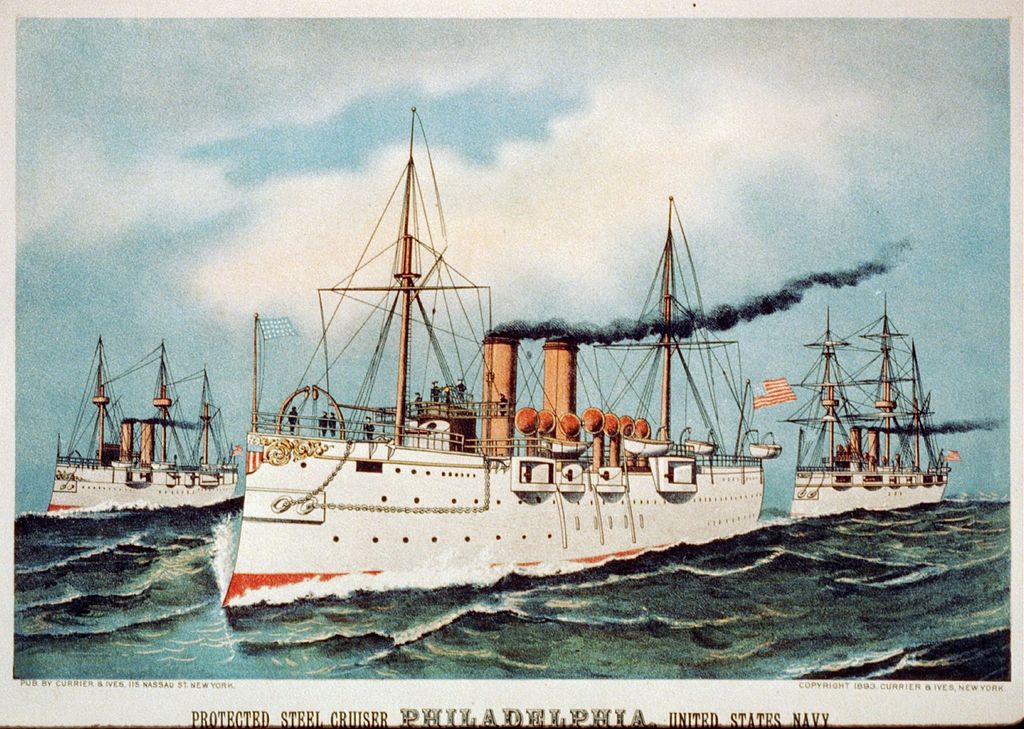
Commemorative print, 1893, showing the Protected steel cruiser Philadelphia, United States Navy and other vessels. New York: Published by Currier & Ives. A size. Chromolithograph. Currier & Ives : a catalogue raisonné / compiled by Gale Research. Detroit, MI : Gale Research, c1983, no. 5384
Protection
References vary there and the most common figures are 3 in (76 mm) gun shields (versus 4.5 in or 110mm on Baltimore) and a 3 in (76 mm) conning tower (same). The armored deck comprised a turtleback section at the waterline, which was thickes on the slopes, at 4 in (100 mm) and thinner on the flat section (figures unknown) as on Baltimore. This seems light especially compared to their own artillery and it was coherent with the status of “protected” cruisers (something rather than nothing), only intended to protect against destroyers and torpedo boats, or unprotected cruisers and gunboats.
Armament
USS Philadelphia being built on Navy Department plans was quite different from British practice. As said above her fore and aft 8 inches main guns were dispended of and instead, twelve 6-inch (152 mm)/30 caliber guns were installed. Two were located by pairs at the bow and stern, and the remainder eight in sponsons port and starboard, two in protruding enclosed casemate sponsoned and two in inner sponson position under shields. Light armament described below. They also had on paper four 14-inch (356 mm) torpedo tubes but they were never mounted. Typically this would have been one fixed in the bow, one in the tern, two underwater on the broadside.
6-inch/30-caliber gun Mark 3

Same model as other US cruisers from the ABCD and onwards but of the model Mark 3 (ISS Dolphin had Mark 1, The Atlanta class Mark 2). They were shared by USS Maine, Texas, Newark, Charleston and Baltimore among others. Central-pivot 196 in (5,000 mm) long, c10,000 lb (4,700 kg).
In short: −10° to +12° elevation, 0.66 rpm, 105 lb (48 kg) naval armor-piercing shell, 1,950 ft/s (590 m/s), range 9,000 yd (8,200 m) at 15.3° elevation.
6-pounder (57 mm (2.2 in))
Four of them, located in hull casemates fore and aft. 57x307R, 25 rpm, mv 1,818 feet per second (554 m/s) max range 4,000 yards (3,700 m)
3-pounder (47 mm (1.85 in)) Hotchkiss
Four, located in the upper platforms on the roof of the main casemates fore and aft. Fixed QF 47×376 mm R 3 kg (6.6 lb), 30 rpm mv 571 m/s (1,870 ft/s) range 5.9 km (3.7 mi) at +20°.
1 pdr
Two 1-pounder (37 mm (1.5 in)) Hotchkiss revolving cannon located in the fighting tops alongside the two .45 caliber (11.4 mm) Gatling guns.
Similar to the British water-jacketed guns, rapid fire. The gun was originally a scaled up Maxim machine gun (Maxim-Nordenfelt 37 mm). It was belt fed, up to 300 rpm cyclic. mv 1,800 ft/s (550 m/s and max range 4,500 yards (4,110 m).
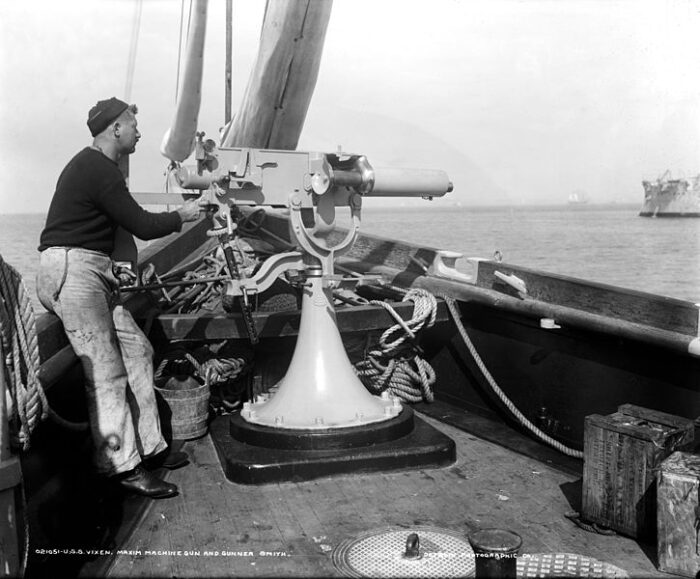
Maxim-Nordenfelt HMG on USS Vixen
⚙ specifications |
|
| Displacement | 4,324 long tons (4,393 t) standard, 5,304 long tons (5,389 t) full load |
| Dimensions | 335 ft x 48 ft 6 in x 23 ft 6 in (102 x 14.78 x 7.16 m max) |
| Propulsion | 2× HTE steam engines, 9× steam boilers, 10,500 ihp (7,800 kW) |
| Speed | 19 knots (35 km/h; 22 mph) |
| Range | 6,354 nmi (11,768 km; 7,312 mi) at 10 kn (19 km/h; 12 mph) |
| Armament | 12× 6-in/30 RML, 4×6-pdr, 4×3-pdr, 2×1-pdr, 2× 0.45 in Gatling guns |
| Protection | Gun shields 3 in, Main deck 4 in, CT 3 in |
| Crew | 384 officers and enlisted |
Career of USS Philadelphia
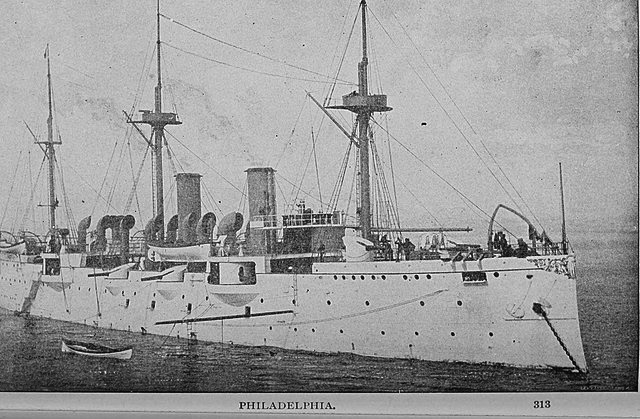
USS Philadelphia had a short operational career. She was laid down on 22 March 1888, launched on 7 September 1889 (sponsored by Miss Minnie Wanamaker, daughter of merchant and philanthropist John Wanamaker) and Commissioned on 28 July 1890, fitted out at the New York Navy Yard. On 18 August she became flagship, Rear Admiral Bancroft Gherardi, North Atlantic Squadron. The squadron departed New York on 19 January 1891 for the West Indies to protect US citizens interests until May. Fred J. Buenzle served aboard and wrote “Bluejacket; An Autobiography”. Next she led the squadron as far north as Halifax, Nova Scotia. Next she called at Montevideo in Uruguay on 6–18 February, and resumed cruising in the West Indies.
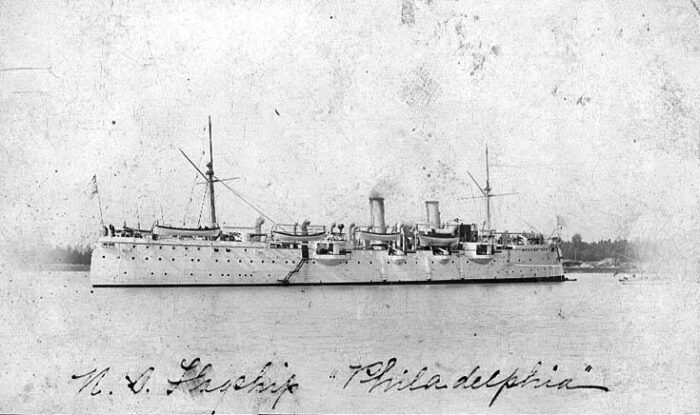
The next year she repeated Atlantic Squadron exercises, eastern seaboard, West Indies, until 1 March 1893. Next she was assigned to the Naval Review Fleet (flagship still) and conducted the International meeting and Review, twelve US ships receiving internaitonal fleets and leading them to Hampton Roads on 8 April. She then led the fleets to New York on 24 April, joining more foreign visitors with a combined fleet of 35 large cruisers and battleships. President Grover Cleveland assisted it on 27 April, with festive ceremonies and a parade of various sailors’s bands through the streets of New York. This was over on 31 May and Philadelphia departed New York on 30 June 1893 to be reassigned to the Pacific Squadron via Rio de Janeiro and Callao in Peru.
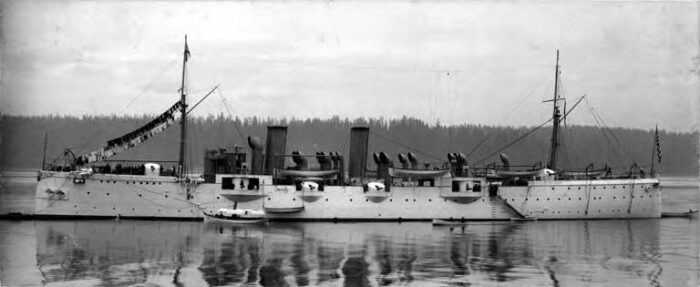
She made it into San Francisco 22 August 1893 as flagship, CIC Pacific Station for drills and maneuvers, ports visits on the US west coast as well as Mexico and South America. Sh led the squadron as well to the Hawaiian Islands and ended in Mare Island Navy Yard 14 October 1897, decommissioned on 18 December.
She was recommissioned 9 July 1898 as tensions rose with Spain, now as flagship, Rear Admiral J. N. Miller (CiC Pacific Station). She left San Francisco on 2 July for ceremonies attending the assumption of sovereignty by the United States over the Hawaiian Islands, arriving at Honolulu on 3 August, spending nine days together with thesteam sloop Mohican and with Marines and armed sailors to represent the US Navy at the ceremonies transferring control of the Hawaiian Islands to the United States, and protect these against the natives.
USS Philadelphia off Honolulu
In March 1899, CiC Rear Admiral Albert Kautz came on board when she sailed to the Samoan Islands to settle a rebellion faced by the Samoan Commissioners or the US as well as from Great Britain and Germany. She sent a landing party at Vailele 1 April to meet with a British landing party. While inland they were ambushed by a force sent by Chief Mataafa, and took 7 killed and 7 wounded, including two officers: Lieutenant Philip Lansdale and Ensign John R. Monaghan. Philadelphia remained in Samoan waters until 21 May 1899, and proceeded home via Honolulu.
She remained flagship of the Pacific Station until 6 February 1900, Rear Admiral Kautz transferring his mark to USS Iowa (BB-4). She remained in operations until 1902 alrenating training cruises, drills and target practice as well as port visits.
She proceeded to Panama and resides there for six months before sailing to San Francisco, arriving on 17 July 1902. She was to have an extensive overhaul and sailed to Puget Sound Navy Yard , being decommissioned for its duration, on 22 September 1902.
Philadelphia was not just modernized to return to service as a cruise. She was now considered of an obsolete design and too slow for fleet actions. Instead she was onverted as an accomodation ship. She was housed over, officially becoming a receiving ship at Puget Sound Navy Yard on 12 May 1904, until 4 November 1912, then turned into a prison ship, and receiving ship again from 10 January 1916, now under hull number IX-24 to free her name from 17 July 1920. She was stricken on 24 November 1926, sold at public auction at Puget Sound in 1927 to Louis Rotherberg and BU.
Read More/Src
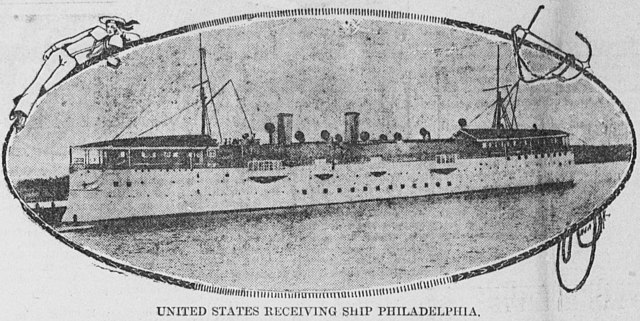
Books
Bauer, K. Jack; Roberts, Stephen S. (1991). Register of Ships of the U.S. Navy, 1775–1990: Major Combatants. Greenwood Press
Buenzle, Fred J. (1986). Bluejacket: An Autobiography. Annapolis: Naval Institute Press.
Burr, Lawrence. US Cruisers 1883–1904: The Birth of the Steel Navy. Oxford : Osprey, 2008.
Friedman, Norman (1984). U.S. Cruisers: An Illustrated Design History. Annapolis, Maryland: Naval Institute Press.
Gardiner, Robert; Chesneau, Roger (1979). Conway’s All the World’s Fighting Ships 1860–1905. New York: Mayflower Books.
The White Squadron. Toledo, Ohio: Woolson Spice Co., 1891. OCLC 45112425
United States. Hand Book of the U.S.S. Philadelphia. [Place of publication not identified]: U.S.S. Philadelphia, 1892.
Wright, C. C. (2004). “Question 55/02: USS Philadelphia (C-4)”. Warship International. XLI (1): 18–19.
Wright, C. C. (2004). “Question 55/02: USS Philadelphia (C-4)”. Warship International. XLI (2): 115–121.
Wright, C. C. (2003). “Question 55/02: USS Philadelphia (C-4)”. Warship International. XL (4): 300–301.
Links
on navypedia.org
navweaps.com/ 6 inches/30 mk1
on commons.wikimedia.org
on history.navy.mil
globalsecurity.org/ c-4.htm


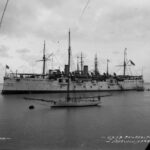
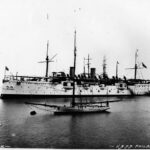

 Latest Facebook Entry -
Latest Facebook Entry -  X(Tweeter) Naval Encyclopedia's deck archive
X(Tweeter) Naval Encyclopedia's deck archive Instagram (@navalencyc)
Instagram (@navalencyc)





 French Navy
French Navy Royal Navy
Royal Navy Russian Navy
Russian Navy Armada Espanola
Armada Espanola Austrian Navy
Austrian Navy K.u.K. Kriegsmarine
K.u.K. Kriegsmarine Dansk Marine
Dansk Marine Nautiko Hellenon
Nautiko Hellenon Koninklije Marine 1870
Koninklije Marine 1870 Marinha do Brasil
Marinha do Brasil Osmanlı Donanması
Osmanlı Donanması Marina Do Peru
Marina Do Peru Marinha do Portugal
Marinha do Portugal Regia Marina 1870
Regia Marina 1870 Nihhon Kaigun 1870
Nihhon Kaigun 1870 Preußische Marine 1870
Preußische Marine 1870 Russkiy Flot 1870
Russkiy Flot 1870 Svenska marinen
Svenska marinen Søværnet
Søværnet Union Navy
Union Navy Confederate Navy
Confederate Navy Armada de Argentina
Armada de Argentina Imperial Chinese Navy
Imperial Chinese Navy Marinha do Portugal
Marinha do Portugal Mexico
Mexico Kaiserliche Marine
Kaiserliche Marine 1898 US Navy
1898 US Navy Sovietskiy Flot
Sovietskiy Flot Royal Canadian Navy
Royal Canadian Navy Royal Australian Navy
Royal Australian Navy RNZN Fleet
RNZN Fleet Chinese Navy 1937
Chinese Navy 1937 Kriegsmarine
Kriegsmarine Chilean Navy
Chilean Navy Danish Navy
Danish Navy Finnish Navy
Finnish Navy Hellenic Navy
Hellenic Navy Polish Navy
Polish Navy Romanian Navy
Romanian Navy Turkish Navy
Turkish Navy Royal Yugoslav Navy
Royal Yugoslav Navy Royal Thai Navy
Royal Thai Navy Minor Navies
Minor Navies Albania
Albania Austria
Austria Belgium
Belgium Columbia
Columbia Costa Rica
Costa Rica Cuba
Cuba Czechoslovakia
Czechoslovakia Dominican Republic
Dominican Republic Haiti
Haiti Hungary
Hungary Honduras
Honduras Estonia
Estonia Iceland
Iceland Eire
Eire Equador
Equador Iran
Iran Iraq
Iraq Latvia
Latvia Liberia
Liberia Lithuania
Lithuania Mandchukuo
Mandchukuo Morocco
Morocco Nicaragua
Nicaragua Persia
Persia San Salvador
San Salvador Sarawak
Sarawak Uruguay
Uruguay Venezuela
Venezuela Zanzibar
Zanzibar Warsaw Pact Navies
Warsaw Pact Navies Bulgaria
Bulgaria Hungary
Hungary

 Bundesmarine
Bundesmarine Dutch Navy
Dutch Navy Hellenic Navy
Hellenic Navy Marina Militare
Marina Militare Yugoslav Navy
Yugoslav Navy Chinese Navy
Chinese Navy Indian Navy
Indian Navy Indonesian Navy
Indonesian Navy JMSDF
JMSDF North Korean Navy
North Korean Navy Pakistani Navy
Pakistani Navy Philippines Navy
Philippines Navy ROKN
ROKN Rep. of Singapore Navy
Rep. of Singapore Navy Taiwanese Navy
Taiwanese Navy IDF Navy
IDF Navy Saudi Navy
Saudi Navy Royal New Zealand Navy
Royal New Zealand Navy Egyptian Navy
Egyptian Navy South African Navy
South African Navy






























 Ukrainian Navy
Ukrainian Navy dbodesign
dbodesign